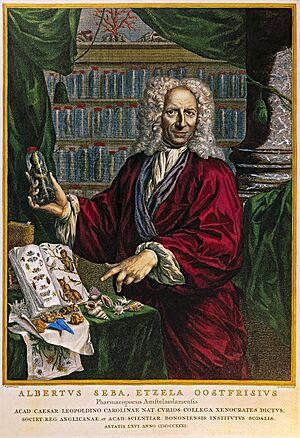Albertus Seba facts for kids

Albertus Seba (born May 12, 1665, in Etzel, died May 2, 1736, in Amsterdam) was a Dutch pharmacist, zoologist, and collector. He gathered one of the largest "cabinets of curiosities" in the Netherlands during his time. These were like personal museums filled with interesting natural items. In 1717, he sold one of his collections to Peter the Great, the ruler of Russia. After his death, his other collections were sold at an auction. Seba wrote detailed books about his collections, which were filled with beautiful pictures. His early work on how to group animals and plants, called taxonomy, influenced famous scientists like Carl Linnaeus.
Contents
Albertus Seba's Amazing Career
Albertus Seba was born in a place called Etzel. He moved to Amsterdam to become an apprentice (a trainee) in pharmacy. Around 1700, he opened his own pharmacy near the busy harbor. Seba often asked sailors and ship doctors to bring him interesting plants and animal parts from their travels. He used these items to make medicines. Soon, Seba also started collecting snakes, birds, insects, shells, and lizards in his own home.
Supplying the Russian Court
From 1711, Seba sent various medicines to the Russian royal family in Saint Petersburg. Sometimes, he even accepted fresh ginger as payment! Seba told Robert Erskine, who was the tsar's main doctor, about his amazing collection. In early 1716, Peter the Great himself bought Seba's entire collection. Over the next few years, Seba built up a brand new collection of natural specimens. This second collection grew even bigger than the first one!
Seba also helped another famous Amsterdam doctor, Frederik Ruysch, sell his collection to the tsar. These two large collections greatly expanded Peter the Great's imperial "cabinet of curiosities." They even led to the creation of the Russian Academy of Sciences. A new building, the Kunstkammer, was built for these collections. It opened in 1728 as Russia's first public museum.
Seba's Famous Book: The Thesaurus
In October 1728, Seba became a Fellow of the Royal Society, which is a very important scientific group. In 1734, he published a Latin book about his animal specimens. This book was filled with beautiful pictures and detailed drawings. Its long Latin title is usually shortened to the Rerum Naturalium Thesaurus, which means "A Treasury of Nature." People also sometimes call it A Cabinet of Natural Curiosities.
The book had four volumes. The last two volumes were published after Seba passed away, in 1759 and 1765. Today, a full original volume with 446 plates (pages with pictures) is kept at the National Library of the Netherlands in The Hague. Recently, a complete set of Seba's Thesaurus sold for $460,000 at an auction! In 2001, a company called Taschen Books made a new reprint of the Thesaurus.
Seba's Influence on Carl Linnaeus
In 1735, the famous scientist Carl Linnaeus visited Seba twice. Linnaeus found Seba's collection very helpful for the system he was creating to classify (group) living things. Linnaeus used many of Seba's specimens as examples for his original descriptions of different species. Seba's book even included drawings of strange creatures, like a "hydra." This influenced Linnaeus to include a section called "Paradoxa" in his book Systema Naturae. This section was for species that might exist but hadn't been fully proven.
Seba himself did not use Linnaeus's classification system. This is because Linnaeus's system was published only a year before Seba died. However, Seba did organize his Thesaurus by how similar the animals looked. This led to some similarities with Linnaeus's bigger project.
Several years after Seba's death, in 1752, his second collection was sold at an auction in Amsterdam. The Russian Academy of Sciences bought several items from this sale.
Animals Named After Seba
Seba is honored in the scientific names of two types of snakes and one subspecies of snake:
Gallery
-
Engraving depicting different views of the hedgehog in the Thesaurus
-
The Hamburg Hydra, from the 1st volume (1734)




